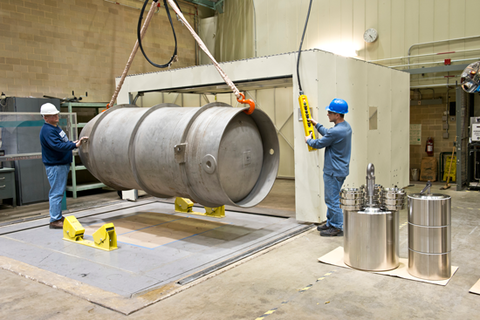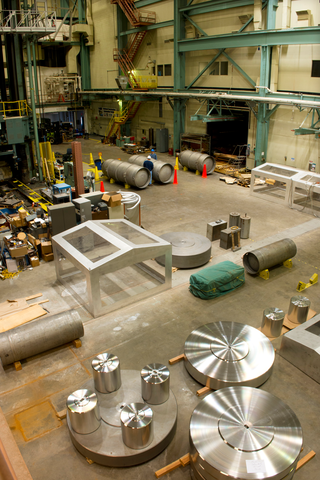
Paul Emanuel (left) and Kevin Chesnutwood carefully hoist a container off its floor mount atop the platform of the large-mass balance-beam scale. The PML reference masses used for the calibration are stacked at the right.
Few substances are tracked more closely and stored more carefully than the nuclear waste produced at power plants and elsewhere. So the properties of the large cylindrical containers used to hold material such as spent fuel rods must be known to a high accuracy. But it is very difficult to determine the mass of a heavily clad container with an irregular shape that is as long as a full-size car and can weigh 10 times as much. Not surprisingly, many measurement jobs of that scale end up at NIST.
"We can measure a 30,000 pound object to an uncertainty of less than one-tenth of one pound," says Zeina Kubarych, leader of the Mass and Force Group in PML's Quantum Measurement Division. That's around three parts in a million. "This is the only facility that I know of in the world that provides calibrations for this range of masses at this level of precision," she says.
Kubarych's team recently finished calibrating a set of six nuclear waste reference containers (called replica mass standards) ranging from 1,400 pounds to 32,500 pounds for U.S. Enrichment Corporation. Those containers will be used as reference calibration standards which will then be used to calibrate working units.
"For that kind of work, each of our measurement series can take several hours," says Mass and Force scientist Kevin Chesnutwood. "You have to stay very focused. The weights have to be placed on the scale in the same manner every time to achieve the best repeatability."
In addition, each measurement is corrected for other factors including air buoyancy, which in turn depends on the weather. "We do a real-time calculation of the air density, which is formulated from the barometric pressure and relative humidity," Chesnutwood says. "Our balance-beam scale, which has many, many knife edges, is also affected by the weather and is located in a very stable environment." The balance is rated for a maximum load of nearly 28,000 kilograms (approximately 61,000 pounds).

"Often our customers don't just want them calibrated, but also adjusted to a certain mass value," Kubarych says. "That's usually done by adding material to adjustment cavities built into the weights, which are then sealed at completion. It takes a few iterations of measurements to achieve that – the process is special and very time-consuming.
"In addition, we consult a lot with people who are trying to design a deadweight machine and answer a lot of questions about calibrating the weights and what can we calibrate to what precision."
Everything, of course, has to be traceable to the U.S. primary national standard: the platinum-iridium artifact known as K20, one of the original 1884 replicas of the International Prototype Kilogram. So any changes in the Mass and Force Group's standards necessarily entail a chain of calibrations all the way up from K20 – which itself was recalibrated in 2010 against the international prototype.
This painstaking process, which proceeds seriatim from 1 kg to 2 kg to 5 kg to 10 kg to 20 kg to 50 kg, and so forth, eventually arrives at 500 pounds. (Very large masses are often expressed in pounds for historical reasons, just as many NIST measurements for the petroleum industry are expressed in gallons or barrels.)
From there, the stepwise process proceeds until there are fully calibrated 20,000 pound and 30,000 pound mass standards, which allows combinations of standards that enable the team to use the full capacity of the balance.
That entire sequence consumes a substantial amount of time. "Back in 2010, we acquired some new standard masses," Kubarych says. "Some of the older large masses were cast steel, and thus were not as stable over time as we need. So we supplemented what we already had with new standards, all stainless steel with well characterized densities. The old sets were decommissioned. But first we had to recalibrate those new standards all the way from the prototype. We finally finished in December of 2012."
"The whole dissemination process of working up and down from the kilogram to all of our working mass standards would take a solid six months of work if you did nothing," Chesnutwood says. "In practical terms, it can take up to two years."
With the new standards, and the implementation of statistical process control in all measurements, the group's uncertainties have improved over the past 10 years.
The whole large-mass facility was originally designed to enable periodic recalibration of the numerous 50,000 pound masses used in NIST's million-pound (4.448 meganewton) deadweight machine. But it quickly acquired a considerable customer base from industry, including U.S. Enrichment Corp.'s nuclear waste canisters.
"That's one of our most challenging jobs," Chesnutwood says, "handling objects that big that are not of nominal size and shape. But then, every large-mass job is sort of a special case in a sense. We need to know how the customers are going to use the measurements, because they are often used in unique circumstances."
Any mention or image of commercial products within NIST web pages is for information only; it does not imply recommendation or endorsement by NIST.


